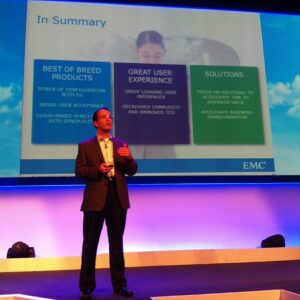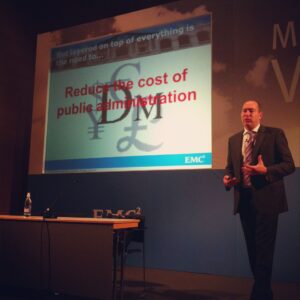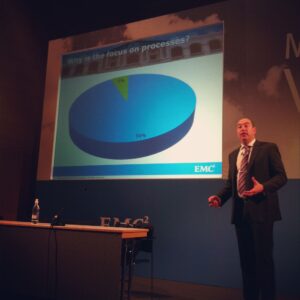
They started by defining what the New User really means:
“Clean, modern UI, access to info everywhere, on any devices, and wirh diversity of content types”
The move to D2 was because a realization of a more agile process away from traditional coding practices and towards easy instant configuration. As in Vegas people pointed out that it is not just about configuring the user experience but also a rules engine for content. One reason EMC acquired D2 was a realization that customers didn’t fit in the previous product boxes like knowledge worker, rich media, process etc. David also introduced an explanation of the difference between D2 and xCP which I think is the best yet:
xCP is configuration for “design-time” while D2 is config for “run-time”
The message was also that the usability that we all strive for comes when the UI is easy to use but also very easy to configure to different user’s needs. Today version 3.1 of D2 is consider the Power User tool but the plan is to move all these features gradually to 4.x releases of D2.
Future
Rich Media viewer aligned with xCP is planned (showed video preview with collection objects in a lower bar) as well as some Centerstage features.
Ver 4.1 is planned for Q2 2013 and include the following features:
- Advanced search with facets
- Virtual document editing
- Native annotation (just basic – still a place for 3rd party tools)
- Syncplicty and mobile integration
- Extended widget integration
- Rich text comments
- Advanced property inheritance
- IRM integration
- Custom menus
- Administration widget
- Public API for integration into external zoos
- Distributed administration
When it comes to partner integrations things like the Brava viewer is supported in 4.1 and I think both an Active-X and HTML version of it.
Integration of the Euroscript reporting tool was also highlighted which of course make one wonder what the status is for Crystal Reports in the future. Earlier we saw a demo of Euroscript which featured reports in widgets that changed when interacting with other widgets in the UI.
Future D2 releases:
- Personalized home page
- Ability to package components in xCP as widgets for D2
- Data tables
When it comes to mobile in the short term:
- iOS 6 platform support
- Support for iPhone 5 (form factor adjustments)
- D2 Workflow config in order to support electronic signature signoffs and adding notes and comments to a workflow task.
In the longer perspective they see mobile clients both leverage D2 and xCP configuration. Clients based on HTML 5 for multi-platform support. The ambition is to have mobile clients fully integrated with information management and governance.

